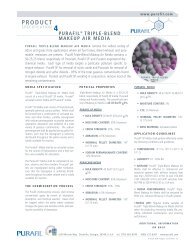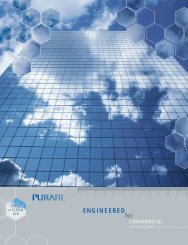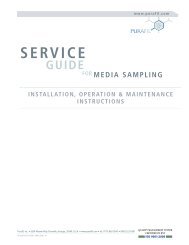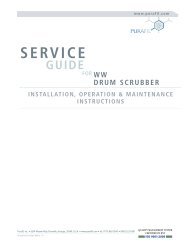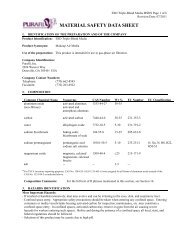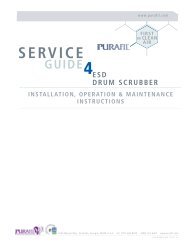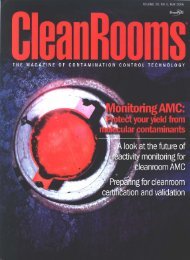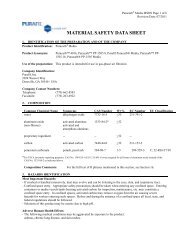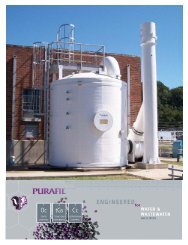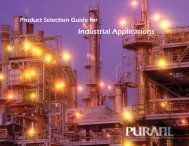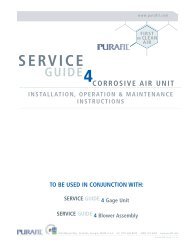AMC Control in Semiconductor Fabs - Purafil
AMC Control in Semiconductor Fabs - Purafil
AMC Control in Semiconductor Fabs - Purafil
You also want an ePaper? Increase the reach of your titles
YUMPU automatically turns print PDFs into web optimized ePapers that Google loves.
FT16- 20/4<br />
A i r b o rne Molecular Contam<strong>in</strong>ation<br />
<strong>Control</strong> <strong>in</strong> <strong>Semiconductor</strong> <strong>Fabs</strong>:<br />
A Practical Approach<br />
CH R I S MU L L E R, <strong>Purafil</strong>, Inc., Doraville, GE, USA<br />
A B S T R A C T<br />
As semiconductor device geometry cont<strong>in</strong>ues<br />
to decrease <strong>in</strong>to the deep sub-micron level,<br />
chemical contam<strong>in</strong>ation has become as import a n t<br />
as particulate contam<strong>in</strong>ation. Airborne molecular<br />
contam<strong>in</strong>ation (<strong>AMC</strong>) can impact almost all aspects<br />
of sub-micron device fabrication, from overall fab<br />
operation to f<strong>in</strong>al device perf o rmance.<br />
Ac c o rd<strong>in</strong>g to SEMAT E C H ’s International Te c h n o l o g y<br />
Roadmap for <strong>Semiconductor</strong>s [1], the perc e n t a g e<br />
of process steps affected by non-part i c u l a t e<br />
or molecular contam<strong>in</strong>ation is expected to <strong>in</strong>crease. Pre -<br />
gate oxidation, salicidation, contact formation, and<br />
DUV photolithography have been identified as part i c u-<br />
larly sensitive production steps. New chemistries<br />
i n t roduced to manufactur<strong>in</strong>g processes have also<br />
been shown to cause unforeseen <strong>AMC</strong>-related eff e c t s .<br />
H y d rogen sulphide, for example, poses a significant thre a t<br />
to the metallisation process as the transition is made<br />
f rom alum<strong>in</strong>ium to copper.<br />
As copper appears ready to become the ma<strong>in</strong><br />
on-chip conductor for all types of <strong>in</strong>tegrated<br />
c i rcuits, it is show<strong>in</strong>g up <strong>in</strong> the plans of chip and<br />
p roduction equipment makers worldwide (Figure 1) and<br />
is quicken<strong>in</strong>g the shift to <strong>AMC</strong>-free manufactur<strong>in</strong>g<br />
e n v i ro n m e n t s .<br />
• How can I be assured that I am meet<strong>in</strong>g my <strong>AMC</strong><br />
control criteria?<br />
Even with ongo<strong>in</strong>g re s e a rch, more and more manufact<br />
u rers are turn<strong>in</strong>g to outside sources for the answers to<br />
these questions. Companies that can supply an entire<br />
package of <strong>AMC</strong> control and monitor<strong>in</strong>g services are<br />
becom<strong>in</strong>g <strong>in</strong>creas<strong>in</strong>gly viable and important sources of<br />
<strong>in</strong>formation. They are be<strong>in</strong>g used <strong>in</strong> a quasi-consult<strong>in</strong>g<br />
role to keep their clients abreast of developments <strong>in</strong><br />
<strong>AMC</strong> monitor<strong>in</strong>g and control across the <strong>in</strong>dustry.<br />
C o n t rol of <strong>AMC</strong> has evolved <strong>in</strong>to a 3-step process. The<br />
first is an assessment of the air quality both outside and<br />
<strong>in</strong>side the fab to identify potential target contam<strong>in</strong>ants.<br />
The second is the selection and qualification of an <strong>AMC</strong><br />
c o n t rol system. The f<strong>in</strong>al step is ongo<strong>in</strong>g monitor<strong>in</strong>g of<br />
the controlled environment and the performance of any<br />
<strong>AMC</strong> control systems.<br />
Figure 1<br />
Worldwide sales of copper<br />
W O R L D WI DE SA LE S IN U S$ M I LL IO NS<br />
As <strong>AMC</strong> pushes to the fore f ront <strong>in</strong> the m<strong>in</strong>ds of pro c e s s<br />
and facilities eng<strong>in</strong>eers, they cont<strong>in</strong>ue to seek answers<br />
to a number of basic questions:<br />
• What types and levels of <strong>AMC</strong> are problematic to my<br />
manufactur<strong>in</strong>g operations?<br />
• How do I know what I have <strong>in</strong> my fab?<br />
• If I implement <strong>AMC</strong> control, what <strong>in</strong>creases <strong>in</strong><br />
productivity and/or yield can I expect?<br />
A M C A SS ES SM E N T<br />
B e f o e ra determ<strong>in</strong>ation can be made as to whether <strong>AMC</strong> contro l<br />
is warranted, the environment must be characterised as to<br />
its potential for <strong>AMC</strong>-<strong>in</strong>duced damage or failures. This can<br />
be done with real-time gas monitors although this does not<br />
necessarily provide an <strong>in</strong>dication of the potential effects of<br />
these contam<strong>in</strong>ants. Unless a specific contam<strong>in</strong>ant has<br />
been characterised as to its effect(s) on materials and<br />
p rocesses, one can only speculate as to what its presence will<br />
mean to product reliability and yield. Even if a specific contam<strong>in</strong>ant<br />
has been well characterised, e.g. ammonia <strong>in</strong><br />
lithography processes or chlor<strong>in</strong>e <strong>in</strong> metallisation and<br />
S E M I C O N D U C T O R FA B T E C H – 16 t h E D I T I O N 1
FT16- 20/4<br />
Figure 2<br />
An Environmental Reactivity<br />
Coupon<br />
salicidation, its control alone does not ensure that the<br />
p rocess or device will be defect-free. Direct gas monitor<strong>in</strong>g<br />
does not take <strong>in</strong>to account the possible synergies – positive<br />
and negative – between different chemical species.<br />
Reactivity monitor<strong>in</strong>g, however, can show the effects<br />
of <strong>AMC</strong> on materials and is be<strong>in</strong>g used <strong>in</strong> fabs to<br />
perform air quality assessments. Environmental classifications<br />
us<strong>in</strong>g reactivity monitor<strong>in</strong>g are designed to<br />
characterise the destructive potential of an enviro n-<br />
ment and have been accepted as a viable alternative to<br />
d i rect monitor<strong>in</strong>g of low-level gaseous contam<strong>in</strong>ants [3,4,5].<br />
Reactivity monitor<strong>in</strong>g is be<strong>in</strong>g used for the characterisation<br />
of makeup air, identification of <strong>AMC</strong> hot spots,<br />
and to track <strong>AMC</strong> <strong>in</strong>cidents with<strong>in</strong> a fab with the<br />
ultimate goal of establish<strong>in</strong>g the cause-and-effect re l a t i o n-<br />
ship between <strong>AMC</strong> and product yields/losses.<br />
The classification scheme shown <strong>in</strong> Table 1 directly<br />
c o r relates corrosion rates to environmental classifications.<br />
These classifications – both <strong>in</strong> terms of the classification<br />
level and the correspond<strong>in</strong>g reactivity rates – are be<strong>in</strong>g<br />
ref<strong>in</strong>ed based on the results of test<strong>in</strong>g, <strong>in</strong>put fro m<br />
m a n u f a c t u ers, r and the specific needs of the <strong>in</strong>dustry [6,7].<br />
Individual corrosion films can be quantified and used<br />
to further characterise the environment, and assist <strong>in</strong><br />
determ<strong>in</strong><strong>in</strong>g the proper <strong>AMC</strong> control strategies. Relevant<br />
acceptance criteria have been determ<strong>in</strong>ed and these take<br />
<strong>in</strong>to account total corrosion as well as the relative contribution<br />
of each <strong>in</strong>dividual corrosion film (Table 2). These<br />
specifications are more general <strong>in</strong> their application and are<br />
often used for the characterisation of an environment prior<br />
to the implementation of specific <strong>AMC</strong> control measure s .<br />
E n v i ronmental reactivity coupons (ERCs, Fi g u re 2)<br />
employ<strong>in</strong>g copper and silver coupons may be used to <strong>in</strong>dicate<br />
the presence of many different types of <strong>AMC</strong> <strong>in</strong>clud<strong>in</strong>g<br />
acids, bases, and solvents – all of which have been cited<br />
as the cause of a number of <strong>AMC</strong>-related process effects.<br />
ERCs are commonly used for evaluat<strong>in</strong>g long-term air quality<br />
t rends <strong>in</strong>side and outside a facility and <strong>in</strong> perform<strong>in</strong>g enviro n-<br />
mental surveys as part of the development of an <strong>AMC</strong> contro l<br />
p rogramme. They can also be used to differe n t i a t e<br />
TA B L E 1. EN V I R O N M E N TA L CL A S S I F I C AT I O N S F O R SE M I C O N D U C T O R CL E A N R O O M S<br />
Copper Reactivity<br />
Silver Reactivity<br />
Class Air QualityClassification Reactivity Rate Class Air QualityClassification Reactivity Rate<br />
C1 Pure
FT16- 20/4<br />
between classes of chemical contam<strong>in</strong>ants and to pro v i d e<br />
estimates of <strong>AMC</strong> concentrations.<br />
The ma<strong>in</strong> limitation <strong>in</strong> the use of ERCs is their<br />
<strong>in</strong>ability to provide a cont<strong>in</strong>uous environmental classification.<br />
To address this, reactivity monitor<strong>in</strong>g has been<br />
taken a step further through the development of a realtime<br />
monitor<strong>in</strong>g device employ<strong>in</strong>g metal-plated quartz<br />
crystal microbalances (QCMs) [8,9]. These microp<br />
ro c e s s o r - c o n t olled r devices are able to measure the total<br />
e n v i ronmental corrosion attributable to <strong>AMC</strong> and can detect<br />
changes <strong>in</strong> <strong>AMC</strong> at levels
FT16- 20/4<br />
Figure 4<br />
Copper Reactivity vs Silver<br />
Reactivity<br />
At times semiconductor manufacturers have become so<br />
focused on the control of a s<strong>in</strong>gle contam<strong>in</strong>ant, e.g.,<br />
ammonia <strong>in</strong> lithography, chlor<strong>in</strong>e <strong>in</strong> metallisation, that they<br />
sometimes forget or ignore other contam<strong>in</strong>ants that could<br />
cause entirely different problems from those be<strong>in</strong>g s<strong>in</strong>gled<br />
out. For <strong>in</strong>stance, many ion exchange products are sold for<br />
the control of ammonia but have little if any effect on am<strong>in</strong>es<br />
and NMP. Another filter material is selective for chlor<strong>in</strong>e but<br />
is <strong>in</strong>effective aga<strong>in</strong>st other acids. Ta rget<strong>in</strong>g s<strong>in</strong>gle critical contam<strong>in</strong>ants<br />
will improve yield; however, all <strong>AMC</strong> must be<br />
c o n s i d e red when design<strong>in</strong>g an <strong>AMC</strong> control pro g r a m m e .<br />
Even if they do not have any noticeable effect on pro c e s s e s<br />
or materials, they could very well have an un<strong>in</strong>tended<br />
effect on the particular chemical filter products <strong>in</strong> use.<br />
I m p rov<strong>in</strong>g production, fewer defects, and less re w o r k<br />
all po<strong>in</strong>t to an <strong>in</strong>creased requirement for reduc<strong>in</strong>g and<br />
ma<strong>in</strong>ta<strong>in</strong><strong>in</strong>g low <strong>AMC</strong> levels. Assum<strong>in</strong>g that reduc<strong>in</strong>g or<br />
elim<strong>in</strong>at<strong>in</strong>g <strong>AMC</strong> can help achieve these goals and that<br />
optimum <strong>AMC</strong> control will be achieved through direct<br />
(removal control) rather than <strong>in</strong>direct means (dilution<br />
c o n t rol, etc.), recent experience has identified 4 important<br />
po<strong>in</strong>ts that must be addressed by the facility designer:<br />
• Identification of the air handl<strong>in</strong>g systems that should<br />
have <strong>AMC</strong> control systems <strong>in</strong> place<br />
• Characterisation of the different requirements for<br />
makeup and recirculation air handler systems<br />
• Specification of the <strong>AMC</strong> control equipment, and<br />
• Performance verification, ongo<strong>in</strong>g metrology, and detection<br />
limits.<br />
AM C M O NI T O R I N G<br />
Once an <strong>AMC</strong> control strategy has been decided upon and<br />
implemented – whether it <strong>in</strong>volves the use of chemical filtration<br />
or not – one must be able to monitor the success or<br />
f a i l u re of meet<strong>in</strong>g specified <strong>AMC</strong> control criteria. Where<br />
chemical filtration is be<strong>in</strong>g used, an <strong>AMC</strong> monitor<strong>in</strong>g<br />
p rogramme must be able to provide the follow<strong>in</strong>g.<br />
• Information as to the type(s) of contam<strong>in</strong>ants pre s e n t<br />
and their relative levels.<br />
• Air quality <strong>in</strong>formation correlated to specific air<br />
cleanl<strong>in</strong>ess classifications.<br />
• Chemical filtration system performance assessment.<br />
• Verification of the atta<strong>in</strong>ment of specified or standard<br />
<strong>AMC</strong> levels.<br />
Generally speak<strong>in</strong>g, air quality <strong>in</strong> critical pro c e s s<br />
areas should be a m<strong>in</strong>imum of Class C2 / S2, without<br />
evidence of active sulphur or <strong>in</strong>organic chlor<strong>in</strong>e compounds.<br />
This most often <strong>in</strong>dicates an environment sufficiently wellc<br />
o n t rolled as to prevent <strong>AMC</strong>-related process effects and<br />
d i rect control of <strong>AMC</strong> may not be re q u i red. Where<br />
chemical filtration is be<strong>in</strong>g employed to control <strong>AMC</strong>,<br />
reactivity rates
FT16- 20/4<br />
contam<strong>in</strong>ation control, are either rare or not published.<br />
With the rapid pace of technological advancements,<br />
semiconductor manufacturers have fully recognised the<br />
fact that sensitive electronic and electrical components and<br />
equipment will be damaged if exposed to <strong>AMC</strong>. The<br />
International Technology Roadmap for <strong>Semiconductor</strong>s<br />
has proposed that <strong>AMC</strong> will be the next technical challenge<br />
to overcome <strong>in</strong> order to ma<strong>in</strong>ta<strong>in</strong> high reliability and yield<br />
for semiconductor devices. Next generation semiconductor<br />
devices will re q u i re the strict control of <strong>AMC</strong> <strong>in</strong> order to<br />
a s s u re productivity, competitiveness, and pro f i t a b i l i t y .<br />
M a n u f a c t u rers are actively address<strong>in</strong>g <strong>AMC</strong> and its<br />
c o n t rol, each accord<strong>in</strong>g to the specific re q u i rements of their<br />
own manufactur<strong>in</strong>g processes and concerns.<br />
An assessment of outdoor air quality should be one<br />
of the first steps towards establish<strong>in</strong>g any <strong>AMC</strong> contro l<br />
p rogramme. In review of reactivity monitor<strong>in</strong>g data<br />
f rom semiconductor fabs around the world, there are very<br />
few areas today where the outside air quality would<br />
meet specific area quality requirements with respect to<br />
<strong>AMC</strong>. Even ambient levels are high enough to be of concern.<br />
As the <strong>in</strong>dustry’s knowledge about the damag<strong>in</strong>g effects<br />
of <strong>AMC</strong> on processes and materials cont<strong>in</strong>ues to <strong>in</strong>cre a s e ,<br />
m o re facilities are implement<strong>in</strong>g <strong>AMC</strong> control pro g r a m m e s .<br />
Suppliers of specialised chemical filtration systems are be<strong>in</strong>g<br />
a s ked to assist <strong>in</strong> determ<strong>in</strong><strong>in</strong>g the types of <strong>AMC</strong> pre s e n t ,<br />
the specific control system(s) re q u i red, how best to determ<strong>in</strong>e<br />
if the systems are work<strong>in</strong>g and, if so, whether they are<br />
meet<strong>in</strong>g specific design re q u i re m e n t s .<br />
An air quality classification scheme has been established<br />
for use with reactivity monitor<strong>in</strong>g and it has<br />
ga<strong>in</strong>ed wide acceptance throughout the semiconductor<br />
<strong>in</strong>dustry. Reactivity monitor<strong>in</strong>g can provide <strong>in</strong>formation<br />
as to the types and relative concentrations of many<br />
contam<strong>in</strong>ants problematic to manufactur<strong>in</strong>g pro c e s s e s .<br />
It can provide the <strong>in</strong>formation required to determ<strong>in</strong>e if<br />
d i rect <strong>AMC</strong> control is <strong>in</strong>dicated and, if so, what form it<br />
should take. At the very least it now appears that <strong>in</strong>corporation<br />
of chemical filtration <strong>in</strong>to makeup air handlers<br />
will become a requirement for these facilities.<br />
As the necessity to control chemical contam<strong>in</strong>ation<br />
i n c reases, more <strong>in</strong>formation and feedback from semiconductor<br />
manufacturers is go<strong>in</strong>g to be re q u i red for<br />
cont<strong>in</strong>uous improvement of <strong>AMC</strong> monitor<strong>in</strong>g and contro l<br />
technologies. Intellectual property, new technology,<br />
and competitive considerations must be protected, but<br />
the suppliers of monitor<strong>in</strong>g and control technologies must<br />
be able to address <strong>AMC</strong> issues with as much <strong>in</strong>formation<br />
as possible at their disposal. Only then can we be<br />
assured that we will keep pace with <strong>AMC</strong>.<br />
R E F E R E N C E S<br />
[1] ‘International Technology Roadmap for<br />
<strong>Semiconductor</strong>s: 2000 Update (Defect Reduction),’<br />
<strong>Semiconductor</strong> Industry Association.<br />
[2] Arnold, Bill (2000), ‘Fu t u re of Copper Sh<strong>in</strong>es<br />
T h rough Fog of Transition,’ <strong>Semiconductor</strong><br />
Magaz<strong>in</strong>e, 1(6), pp. 32–36.<br />
[3] K i n kead, Devon (1993), ‘<strong>Control</strong>l<strong>in</strong>g a Killer: How<br />
to W<strong>in</strong> the War Over Gaseous Contam<strong>in</strong>ants,’<br />
CleanRooms, 7(6).<br />
[4] K i n kead, Devon A. (1996), ‘Molecular Contam<strong>in</strong>ants:<br />
Problems and Solutions,’ Proceed<strong>in</strong>gs of the 40th<br />
Annual Technical Meet<strong>in</strong>g, Institute of Enviro n m e n t a l<br />
Sciences, Chicago.<br />
[5] Muller, Chris (1999), ‘Reactivity Monitor<strong>in</strong>g: An<br />
Alternative to Gas Monitor<strong>in</strong>g <strong>in</strong> <strong>Semiconductor</strong><br />
C l e a n rooms?,’ Journal of the IEST, 42(5), pp.19–29.<br />
[ 6 ] Muller, Christopher O. (1998), ‘The Use of Gas-Phase<br />
Air Filtration <strong>in</strong> <strong>Semiconductor</strong> Cleanrooms,’ Pro c e e d i n g s<br />
of the 16th International Conference on Ad v a n c e d<br />
Technologies and Practices for Contam<strong>in</strong>ation Contro l ,<br />
pp. 296–330, PENNWELL Publish<strong>in</strong>g Company.<br />
[7] Muller, Chris (2001), ‘Evaluat<strong>in</strong>g the Effectiveness<br />
of <strong>AMC</strong> <strong>Control</strong> Strategies with Reactivity Monitor<strong>in</strong>g,’<br />
Proceed<strong>in</strong>gs of ESTECH 2001, Institute of<br />
Environmental Sciences, Chicago.<br />
[8] W.G. England, et al., ‘Applications of a Real-Time<br />
E l e c t ronic Contact Corrosion Monitor,’ Pro c e e d i n g s<br />
of Advances <strong>in</strong> Instrumentation and <strong>Control</strong>, Vol 46:<br />
pp 929–955, Instrument Society of America,<br />
Anaheim, 1991.<br />
[9] A.J. Weiller, ‘Electronic Monitor<strong>in</strong>g of Indoor<br />
Atmospheric Pollutants,’ Proceed<strong>in</strong>gs of Healthy<br />
Build<strong>in</strong>gs ’94, pp 241–243, National Coalition on<br />
Indoor Air Quality, 1994.<br />
[10]Bowers, W., ‘Real-Time Ultragravimetric Measure m e n t<br />
of Molecular Contam<strong>in</strong>ants Us<strong>in</strong>g a SAW Sensor,’<br />
Proceed<strong>in</strong>gs of the ICCCS 14th International<br />
Symposium on Contam<strong>in</strong>ation <strong>Control</strong>, 1998.<br />
[11]‘ E n v i ronmental Assessment, Monitor<strong>in</strong>g, and<br />
C o n t rol of Airborne Molecular Contam<strong>in</strong>ation,’<br />
Technical Brochure 1200-B, <strong>Purafil</strong>, Inc., 2001.<br />
[ 1 2 ]Jones, William R., Knight, J. Hunt, and Muller,<br />
Christopher O., ‘Practical Applications of Assessment,<br />
C o n t rol, and Monitor<strong>in</strong>g of <strong>AMC</strong> <strong>in</strong> <strong>Semiconductor</strong><br />
and Disk Drive Manufactur<strong>in</strong>g,’to be presented at<br />
ESTECH 2002, Anaheim, CA, April 28 – May, 1, 2002.<br />
A B O U T T H E A U T H O R<br />
Chris Muller is the Technical Services Manager for <strong>Purafil</strong>, Inc.,<br />
a manufacturer of chemical filtration media, equipment, and<br />
<strong>AMC</strong> monitor<strong>in</strong>g <strong>in</strong>strumentation. He has written and spoken<br />
extensively on the subject of <strong>AMC</strong> control and monitor<strong>in</strong>g<br />
and counts more than 45 papers and articles, and 3 design guides<br />
to his credit. He is a senior member of the IEST and is a<br />
member of work<strong>in</strong>g group WG-CC035: Design Considerations<br />
for Airborne Molecular Contam<strong>in</strong>ation Filtration Systems and<br />
contributes to WG-CC008: Gas-Phase Adsorber Cells. He chairs<br />
AS H RAE’s Standard Project Committee 145P which is develop<strong>in</strong>g<br />
<strong>in</strong>dustry standards for assess<strong>in</strong>g the performance of chemical<br />
filtration systems.<br />
I F Y O U H AV E A N Y E N Q U I R I E S R E G A R D I N G T H E<br />
C O N T E N T O F T H I S A RT I C L E, P L E A S E C O N TA C T:<br />
Chris Muller<br />
Technical Services Manager<br />
<strong>Purafil</strong>, Inc.<br />
2654 Weaver Way<br />
Doraville<br />
Georgia 30045<br />
USA<br />
Tel: +1 (770) 662-8545 ext. 336<br />
Fax: +1 (770) 263-0520<br />
E-mail: chris_muller@purafil.com<br />
SE M I C O N D U C T O R FA B T E C H – 16 t h E D I T I O N 5


